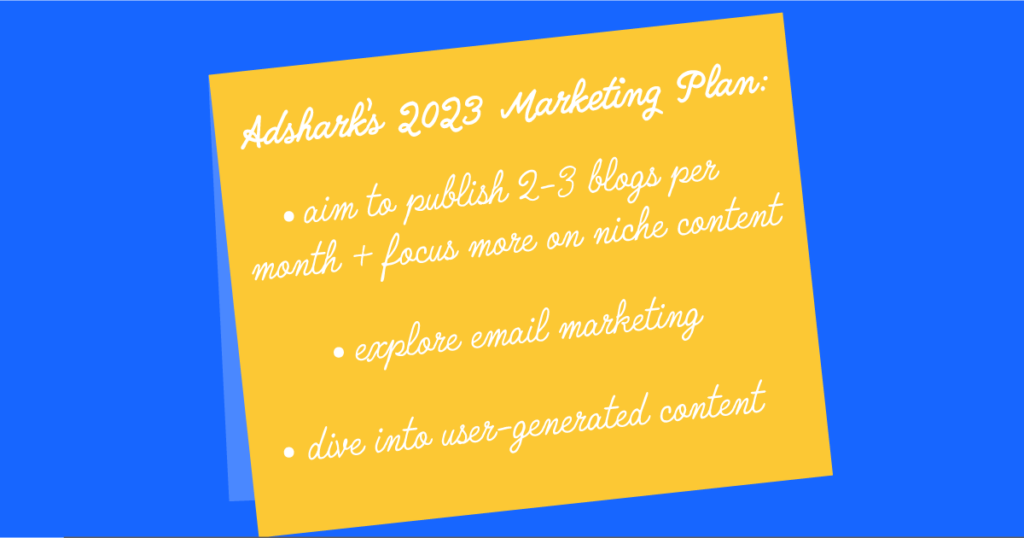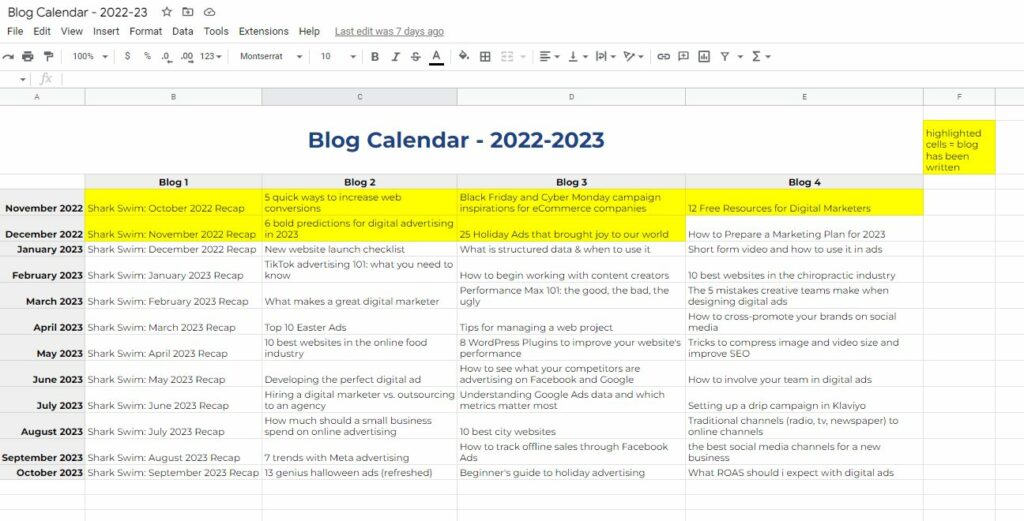
How to Prepare Your 2023 Marketing Plan
In many circles, the week between Christmas and New Years is known as “dead week.” For strategic marketers, however, this can be one of the most lively weeks of the year. 40 hours of quieter email inboxes and less content create the perfect recipe for you to get your strategic planning done.
A couple of week’s ago, we wrote a blog called 6 Bold Predictions for Digital Advertising in 2023. We called out predictions for this upcoming year, including:
- UGC becoming more effective content than traditional video
- Email contacts being more valuable than ever
- TikTok Ads beginning to take some market share from Meta
- …and more.
But for today’s blog, we wanted to go a step further and provide you with guidance and a template to start your strategic planning. For those who have already completed your 2023 marketing plan: congrats! If you haven’t yet: don’t worry. We’ll pass along some advice that will kickstart your efforts starting today. Let’s dive in!
Step 1: Set your marketing goals.
First, it’s important to define what you want to achieve with your marketing efforts. Do you want to increase brand awareness, drive more traffic to your website, or boost conversions? Clearly defining your goals will help you focus your efforts and measure the success of your marketing plan.
Pro Tip: it’s easy to jump into BHAGs (big hairy audacious goals). For marketing goals, think more simple. Rather than “increasing our social media following by 300%” focus on something like “drive stronger engagement rates on our social media posts.

Step 2: Define your target audience.
Knowing who you are trying to reach with your marketing efforts is crucial. Don’t just try to be everything to everybody. Be something to someone. Conduct market research to get a better understanding of your target audience, including their demographics, interests, and pain points. This will help you tailor your marketing efforts to better meet their needs and interests.
Pro Tip: in our marketing plans, we like to call out both a “primary” audience (main target) and “secondary” audience. Each audience may have slightly different marketing messages that resonate with them – bear this in mind when drafting up your plans.
Step 3: Analyze your past marketing efforts.
Look back at your past marketing efforts to see what worked well and what didn’t. Use this information to inform your marketing strategy for the coming year. For example, if a particular social media platform or type of content performed well, consider incorporating more of it into your marketing plan. Cut out the underperforming mediums or tactics.
Pro Tip: make your life easier for years to come by beginning to track your marketing efforts with more diligence. Use spreadsheets, Google’s Looker Studio, or other free tools provided by platforms to determine engagement rates, click-through rates, conversions, and more. Collecting data after the fact is always more tedious.

Step 4: Determine your budget.
Determine how much you can afford to spend on marketing, and allocate your budget accordingly. Consider the cost of different marketing channels, such as social media advertising, email marketing, and content marketing, and choose the ones that will be the most effective for reaching your target audience. Need some help? We wrote a blog about digital advertising budgets last year.
Pro Tip: keep a flexible budget. Go into the year with a loose guideline for what your 2023 spending is going to be, but if certain channels are proving to be profitable to your budget line, leave some room for adding more spend and scaling your efforts. Start conservative enough to not be wasteful, but don’t be so conservative that you miss the opportunity to make an impact.
Step 5: Create a content calendar.
Plan out the content you will create and publish throughout the year. This can include blog posts, social media posts, email newsletters, and more. Having a content calendar will help you stay organized and ensure that you are consistently creating and sharing valuable content with your audience. It also helps your internal marketing team have a good idea of upcoming workload.
Pro Tip: there are several content planning and scheduling tools out there like Buffer, AgoraPulse, CoSchedule, and more. BUT, you can always begin by starting in spreadsheets. Shared below are screenshots of my respective blogging calendar (for our once a week blog) and social media posting calendar (for our 4-5 posts a week social).


Step 6: Choose your marketing channels.
Decide which marketing channels you will use to reach your target audience. This can include social media, email marketing, paid advertising, content marketing, and more. Consider which channels your target audience is most likely to use and allocate your budget accordingly. Need some place to start? Here’s a blog we wrote that lays out the costs & best practices for advertising on the top 5 social media platforms.
Pro Tip: take into consideration the manpower that you have on your team. It’s easy to want to jump into every channel possible, but if you don’t have enough hours or capacity to make it work well, you’ll end up having half-baked efforts across several channels. I’d argue that it’s a lot more viable to fully bake the efforts you put into fewer channels.
Step 7: Track your progress.
It’s important to regularly track the success of your marketing efforts to see what’s working and what’s not. Use tools like Google Analytics to measure website traffic and conversions, and social media analytics to track engagement on your social media accounts. Coordinate your efforts around a few important metrics (KPIs) that you can monitor. Ensure that you are growing above and beyond what you did in 2023.
Pro Tip: manual tracking efforts can be effective in some cases, but we’ve found even more benefit in using Google’s Looker Studio and tying in several data sources – i.e. Google Analytics, Google Search Console, Facebook, Instagram, and more – to keep an eye on the full picture of our efforts.
As you prepare for 2023, it’s important to be mindful of the ever-changing nature of the marketing world. By following these 7 steps, you can create a comprehensive marketing plan that will help your business achieve its goals in 2023. Remember to be flexible and adjust your plan as needed, as the marketing landscape can change quickly.
Quick plug: keep an eye out on the AdShark Marketing Blog for more content to help you get your advertising right in 2023. Thanks for reading, and Happy New Year!


